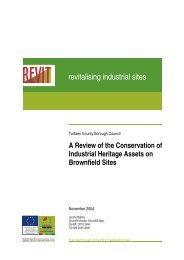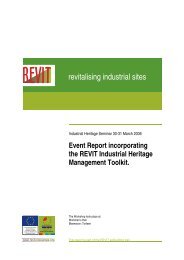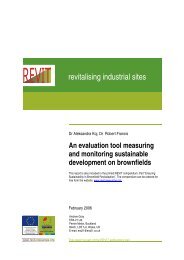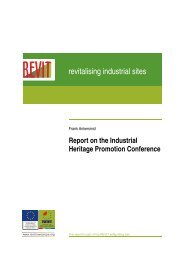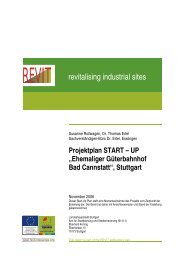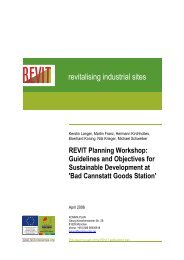DG State Aid – Control and Regeneraton of Deprived Urban ... - REVIT
DG State Aid – Control and Regeneraton of Deprived Urban ... - REVIT
DG State Aid – Control and Regeneraton of Deprived Urban ... - REVIT
You also want an ePaper? Increase the reach of your titles
YUMPU automatically turns print PDFs into web optimized ePapers that Google loves.
framework. A regeneration process is multi-facetted. The Commission appreciates<br />
that different Member <strong>State</strong>s tackle regeneration problems in different ways: they<br />
may wish either to invest directly in regeneration schemes or decide to also involve<br />
the private sector. The approach to regeneration from a state aid point <strong>of</strong> view must<br />
therefore bear this in mind <strong>and</strong> allow room for manoeuvre.<br />
A formal regeneration framework based upon limited experience can quickly turn<br />
out to restrict choices <strong>and</strong> options. Therefore, for the time being, the current state aid<br />
rules <strong>–</strong> applied by <strong>and</strong> enriched through extensive cooperation between Member<br />
<strong>State</strong>s <strong>and</strong> the Commission <strong>–</strong> deliver the necessary flexibility to accommodate all<br />
differing <strong>and</strong> innovative measures in a field that is constantly evolving.<br />
Based on the experience gained with actual <strong>and</strong> future regeneration cases, the<br />
Commission will however continue to assess whether there is a need for an<br />
additional, specific instrument on state aid for undertakings in deprived urban areas.<br />
The Commission’s regeneration track record demonstrates that the state aid regime<br />
is prepared to deal with challenges in regeneration field. Presently, there are a<br />
number <strong>of</strong> possibilities to support regeneration either through a direct application <strong>of</strong><br />
Article 87, in particular 87(3)(c) <strong>of</strong> the EC Treaty, or though horizontal state aid rules,<br />
i.e. Block exemptions, Guidelines for environmental protection, Guidelines for risk<br />
capital, etc.<br />
The sections below give an overview <strong>of</strong> state aid rules that are relevant for the<br />
assessment <strong>of</strong> regeneration measures.<br />
4. Overview <strong>of</strong> state aid rules applicable in the field <strong>of</strong> regeneration<br />
4.1 Basic substantive rules<br />
The basic substantive rules on the control <strong>of</strong> state aid in the EU are set out in Article<br />
87 <strong>of</strong> the EC Treaty. This article provides that state aid is in principle incompatible with<br />
the common market. Article 87(1) <strong>of</strong> the EC Treaty can be broken down into four<br />
tests to establish if a measure within an urban regeneration scheme constitutes state<br />
aid. A state aid will only be present if all four tests are met:<br />
<strong>–</strong> Is the measure granted by the state or through state resources?<br />
<strong>–</strong> Does the measure favour certain undertakings or the production <strong>of</strong> certain<br />
goods 8 ?<br />
<strong>–</strong> Does the measure distort or have the potential to distort competition by<br />
selectively 9 favouring certain beneficiaries?<br />
<strong>–</strong> Does the measure produce an effect on intra-Community trade?<br />
The principle <strong>of</strong> incompatibility <strong>of</strong> state aid with the Treaty is not, however, absolute.<br />
Article 87(2) <strong>and</strong> Article 87(3) contain a number <strong>of</strong> exemptions under which state aid<br />
shall or may be considered compatible by the Commission. In exercising its wide<br />
8 The latter also covers provision <strong>of</strong> services.<br />
9 Selectivity could be with respect <strong>of</strong> the type <strong>of</strong> firms (e.g. small or medium size enterprises), their location (e.g.<br />
a specific region) or their sector <strong>of</strong> activity. In the extreme case, aid could be addressed to one specific firm.<br />
3



